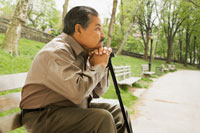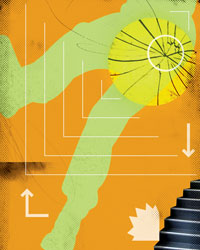AARP Hearing Center
Eight years after Isabelle Jackson fell and broke her hip, she retains two vivid memories of the aftermath. The first is the pain, which was excruciating. The retired schoolteacher from Hannibal, Missouri, now 91, also remembers thinking about her sister, who had fractured her hip and spent the remaining six years of her life in a wheelchair. "I was determined not to be like my sister," says Jackson, who today walks with no assistance and without a limp.
The statistics put Jackson in a select minority: those who not only survive a hip fracture but thrive after one. Of the 300,000 Americans 65 or older who fracture a hip each year, 20 to 30 percent will die within 12 months, and "many more will experience significant functional loss," according to a 2009 study published in The Journal of the American Medical Association (JAMA).
Prevent a Hip Fracture
Take these simple steps to reduce your risk of a broken hip.


Indeed, a year after fracturing a hip, 90 percent of those who needed no assistance climbing stairs before the fracture will not be able to climb five stairs; 66 percent won't be able to get on or off a toilet without help; 50 percent won't be able to raise themselves from a chair; 31 percent won't be able to get out of bed unassisted; and 20 percent won't be able to put on a pair of pants by themselves.
But what makes a hip fracture so deadly — and so debilitating? And how can a seemingly healthy person experience such a dramatic decline from what is essentially a broken bone? The answers have less to do with the break itself than with the response to the break, not just in the hours immediately following but also in the weeks and months post-injury.
Not surprisingly, most young people who fall don't break a hip. But as we age and our bones weaken, a fall that our children or grandchildren might walk away from could put us in the hospital, facing major surgery. That surgery carries risks, yet so does the immobility caused by a broken hip. When you're bedridden and hospitalized, your odds of everything from bedsores to pneumonia increase dramatically.
As people age, they also experience what doctors call comorbidity — multiple ailments at the same time. "Most older adults have at least one chronic condition, such as diabetes or heart problems. Many have two. Then they fall and break a hip. Their whole system is thrown into a tizzy," says Lynn Beattie, vice president of injury prevention for the Center for Healthy Aging in Washington, D.C.
"A hip fracture is an insult to the system, and that changes many metabolic functions," adds Jay Magaziner, Ph.D., chair of the department of epidemiology and public health at the University of Maryland School of Medicine in Baltimore and an expert on hip fractures. "There is something about this kind of injury that amplifies things."


































































More From AARP
Bill Clinton Explains Why He Became a Vegan
Plus check out 6 of his favorite tasty recipes.